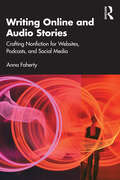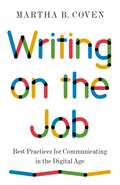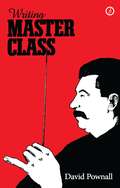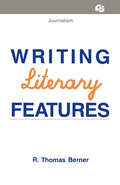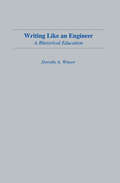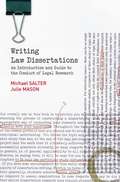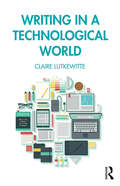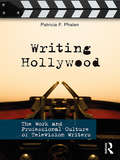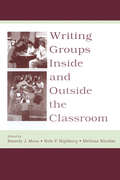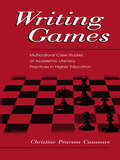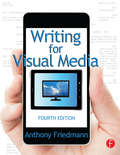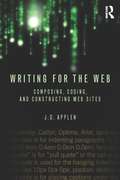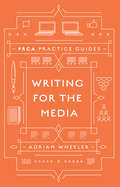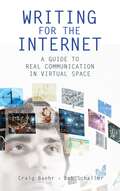- Table View
- List View
Writing Online and Audio Stories: Crafting Nonfiction for Websites, Podcasts, and Social Media
by Anna FahertyGuiding readers through the unique challenges and choices presented by digital publication, this book provides a practical set of tools to help students, creatives, and content professionals craft emotionally engaging nonfiction stories for online readers and listeners. From considering what story to tell, to bringing narratives to life in practice, Anna Faherty explains what gives stories their unique power and demonstrates how to successfully combine techniques from short-stories and screenwriting with journalistic practices like fact checking and verification. Examples from corporate websites, personal blogs, podcasts, and social media set out how to attract and involve readers and listeners, and how to prompt them to take action. Readers will come away with a straightforward framework for planning and crafting storytelling projects and an understanding of text and script development, copyright, and editing. Each chapter includes summaries of key principles and practical writing tips, while case studies share insights from writers’ professional practices – including those who use storytelling to influence customers or advocate for change. Writing Online and Audio Stories is a valuable entry-point for creative writers, podcasters, and professionals in PR and marketing, as well as students undertaking courses such as Digital Writing, Creative Nonfiction and Multimedia Storytelling.
Writing on the Job: Best Practices for Communicating in the Digital Age
by Martha B. CovenA practical and compact guide to writing for professionalsWriting is an essential skill in today’s workplace. From messaging platforms and social media to traditional forms of communication like memos and reports, we rely on words more than ever. Given how much reading we do on mobile devices, being able to write succinctly is critical to success. Writing on the Job is an incisive guide to clear and effective writing for professionals.Martha Coven begins with the basics, explaining how to develop a professional style, get started on a piece of writing, create a first draft, and edit it into a strong final product. She then offers practical advice on more than a dozen forms of writing, from emails and slide decks to proposals and cover letters. Along the way, Coven provides a wealth of concrete examples and simple templates that make the concepts easy to understand and apply.Based on Coven’s popular writing classes and workshops at Princeton University as well as her decades of experience in the public and private sectors, Writing on the Job addresses the real challenges professionals face in today’s digital age, and shares essential practices that can improve the performance of any organization.
Writing on the Job: Best Practices for Communicating in the Digital Age
by Martha B. CovenA practical and compact guide to writing for professionalsWriting is an essential skill in today’s workplace. From messaging platforms and social media to traditional forms of communication like memos and reports, we rely on words more than ever. Given how much reading we do on mobile devices, being able to write succinctly is critical to success. Writing on the Job is an incisive guide to clear and effective writing for professionals.Martha Coven begins with the basics, explaining how to develop a professional style, get started on a piece of writing, create a first draft, and edit it into a strong final product. She then offers practical advice on more than a dozen forms of writing, from emails and slide decks to proposals and cover letters. Along the way, Coven provides a wealth of concrete examples and simple templates that make the concepts easy to understand and apply.Based on Coven’s popular writing classes and workshops at Princeton University as well as her decades of experience in the public and private sectors, Writing on the Job addresses the real challenges professionals face in today’s digital age, and shares essential practices that can improve the performance of any organization.
Writing 'Master Class'
by David PownallWriting Master Class is the biography of David Pownall’s play, Master Class (1983), from conception to coming of age. Threaded through the account of the inception and development of the piece are twists of authorial life-story necessary for the telling. Whereas a novel or poem can be kept a secret until it is properly finished, a play has to go out to meet the people early. On the day the script is put into the hands of actors, the soul of the thing passes out of the author’s control. It can be bent, battered, warped – or improved within its being far beyond expectations. As a drama of dictatorship in art and the cleverness needed to evade its worst manifestations, Master Class has been at large for thirty years, produced in twenty countries, in some several times. What has been done to it, how it has fared, is touched upon but the main story in this book is the making of the piece. This is a fascinating insight into the playwright’s craft.
Writing Literary Features
by R. Thomas BernerFirst Published in 1988. Routledge is an imprint of Taylor & Francis, an informa company.
Writing Literary Features
by R. Thomas BernerFirst Published in 1988. Routledge is an imprint of Taylor & Francis, an informa company.
Writing Like An Engineer: A Rhetorical Education (Rhetoric, Knowledge, and Society Series)
by Dorothy A. WinsorComprised of a study spanning over five years, this text looks at four engineering co-op students as they write at work. Since the contributors have a foot in both worlds -- work and school -- the book should appeal to people who are interested in how students learn to write as well as people who are interested in what writing at work is like. Primarily concerned with whether engineers see their writing as rhetorical or persuasive, the study attempts to describe the students' changing understanding of what it is they do when they write. Two features of engineering practice that have particular impact on the extent to which engineers recognize persuasion are identified: * a reverence for data, and * the hierarchical structure of the organizations in which engineering is most commonly done. Both of these features discourage an open recognition of persuasion. Finally, the study shows that the four co-op students learned most of what they knew about writing at work by engaging in situated practice in the workplace, rather than by attending formal classes.
Writing Like An Engineer: A Rhetorical Education (Rhetoric, Knowledge, and Society Series)
by Dorothy A. WinsorComprised of a study spanning over five years, this text looks at four engineering co-op students as they write at work. Since the contributors have a foot in both worlds -- work and school -- the book should appeal to people who are interested in how students learn to write as well as people who are interested in what writing at work is like. Primarily concerned with whether engineers see their writing as rhetorical or persuasive, the study attempts to describe the students' changing understanding of what it is they do when they write. Two features of engineering practice that have particular impact on the extent to which engineers recognize persuasion are identified: * a reverence for data, and * the hierarchical structure of the organizations in which engineering is most commonly done. Both of these features discourage an open recognition of persuasion. Finally, the study shows that the four co-op students learned most of what they knew about writing at work by engaging in situated practice in the workplace, rather than by attending formal classes.
Writing Law Dissertations: An Introduction And Guide To The Conduct Of Legal Research (PDF)
by Julie Mason Michael SalterThis book covers legal dissertation level research, embracing both LL. B. and the specific demands of LL. M. dissertations. Adopting a highly practical approach, this book shows the reader how to research and write a dissertation, covering the various stages - planning, identifying key issues, utilising the appropriate research methods, time management issues, and managing one's supervision. KEY FEATURES * Shows how to avoid common stylistic and substantive pitfalls * Discusses the character and pros and cons of adopting law and policy methods for defining the issues and conducting legal research - including black letter, socio-legal, interpretive, experiential * A running example throughout the text illustrates the various points made in each section and provides continuity
Writing in a Technological World
by Claire LutkewitteWriting in a Technological World explores how to think rhetorically, act multimodally, and be sensitive to diverse audiences while writing in technological contexts such as social media, websites, podcasts, and mobile technologies. Claire Lutkewitte includes a wealth of assignments, activities, and discussion questions to apply theory to practice in the development of writing skills. Featuring real-world examples from professionals who write using a wide range of technologies, each chapter provides practical suggestions for writing for a variety of purposes and a variety of audiences. By looking at technologies of the past to discover how meanings have evolved over time and applying the present technology to current working contexts, readers will be prepared to meet the writing and technological challenges of the future. This is the ideal text for undergraduate and graduate courses in composition, writing with technologies, and professional/business writing. A supplementary guide for instructors is available at www.routledge.com/9781138580985
Writing in a Technological World
by Claire LutkewitteWriting in a Technological World explores how to think rhetorically, act multimodally, and be sensitive to diverse audiences while writing in technological contexts such as social media, websites, podcasts, and mobile technologies. Claire Lutkewitte includes a wealth of assignments, activities, and discussion questions to apply theory to practice in the development of writing skills. Featuring real-world examples from professionals who write using a wide range of technologies, each chapter provides practical suggestions for writing for a variety of purposes and a variety of audiences. By looking at technologies of the past to discover how meanings have evolved over time and applying the present technology to current working contexts, readers will be prepared to meet the writing and technological challenges of the future. This is the ideal text for undergraduate and graduate courses in composition, writing with technologies, and professional/business writing. A supplementary guide for instructors is available at www.routledge.com/9781138580985
Writing Hollywood: The Work and Professional Culture of Television Writers
by Patricia F. PhalenWriting Hollywood highlights the writing process in the production of television drama and comedy series in the U.S. The way writers do their jobs is heavily dependent not only on the demands of commercial business, but also on the uncertainties inherent in a writing career in Hollywood. Drawing on literature in the fields of Media Industry Studies and Occupational Culture, Writing Hollywood explains writers’ efforts to control risk and survive in a constantly changing environment. Using data from personal interviews and a six-week participant observation at a prime time drama, Dr. Phalen analyzes the relationships among writers in series television, describes the interactions between writers and studio/network executives, and explains how endogenous and exogenous pressures affect the occupational culture of the television writing profession.
Writing Hollywood: The Work and Professional Culture of Television Writers
by Patricia F. PhalenWriting Hollywood highlights the writing process in the production of television drama and comedy series in the U.S. The way writers do their jobs is heavily dependent not only on the demands of commercial business, but also on the uncertainties inherent in a writing career in Hollywood. Drawing on literature in the fields of Media Industry Studies and Occupational Culture, Writing Hollywood explains writers’ efforts to control risk and survive in a constantly changing environment. Using data from personal interviews and a six-week participant observation at a prime time drama, Dr. Phalen analyzes the relationships among writers in series television, describes the interactions between writers and studio/network executives, and explains how endogenous and exogenous pressures affect the occupational culture of the television writing profession.
Writing Groups Inside and Outside the Classroom (International Writing Centers Association (IWCA) Press Series)
by Beverly J. Moss Nels P. Highberg Melissa NicolasThis unique collection considers the nature of writing groups inside and outside the academic environment. Exploring writing groups as contextual literacy events, editors Beverly J. Moss, Nels P. Highberg, and Melissa Nicolas bring together contributors to document and reflect on the various types of collaborations that occur in writing groups in a wide range of settings, both within and outside the academy. The chapters in this volume respond to a variety of questions about writing groups, including: *What is the impact of gender, race, and socioeconomic class on power dynamics in writing groups? *When is a writing group a community and are all writing groups communities? *How does the local community of a writing group impact the participation of group members in other local or global communities? *How does the local community of a writing group impact the participation of group members in other local or global communities? *What actions contribute to a strong community of writers and what actions contribute to the breakdown of community? *When and for whom are writing groups ineffective? *What is it about belonging to a community of writers that makes writing groups appealing to so many within and beyond the academy?Each chapter highlights how writing groups, whether or not they are labeled as such, function in various spaces and locations, and how collaboration works when writers from a variety of backgrounds with diverse interests come together. Writing Groups Inside and Outside the Classroom illustrates that writing groups outside of the academy are worthy of study and serve as important sites of writing and literacy instruction. Offering significant insights into the roles of writing groups in literacy and writing practice, this volume is appropriate for scholars and teachers of writing, rhetoric, composition, and literacy; for writing center administrators and staff; and for writing group participants.
Writing Groups Inside and Outside the Classroom (International Writing Centers Association (IWCA) Press Series)
by Beverly J. Moss Nels P. Highberg Melissa NicolasThis unique collection considers the nature of writing groups inside and outside the academic environment. Exploring writing groups as contextual literacy events, editors Beverly J. Moss, Nels P. Highberg, and Melissa Nicolas bring together contributors to document and reflect on the various types of collaborations that occur in writing groups in a wide range of settings, both within and outside the academy. The chapters in this volume respond to a variety of questions about writing groups, including: *What is the impact of gender, race, and socioeconomic class on power dynamics in writing groups? *When is a writing group a community and are all writing groups communities? *How does the local community of a writing group impact the participation of group members in other local or global communities? *How does the local community of a writing group impact the participation of group members in other local or global communities? *What actions contribute to a strong community of writers and what actions contribute to the breakdown of community? *When and for whom are writing groups ineffective? *What is it about belonging to a community of writers that makes writing groups appealing to so many within and beyond the academy?Each chapter highlights how writing groups, whether or not they are labeled as such, function in various spaces and locations, and how collaboration works when writers from a variety of backgrounds with diverse interests come together. Writing Groups Inside and Outside the Classroom illustrates that writing groups outside of the academy are worthy of study and serve as important sites of writing and literacy instruction. Offering significant insights into the roles of writing groups in literacy and writing practice, this volume is appropriate for scholars and teachers of writing, rhetoric, composition, and literacy; for writing center administrators and staff; and for writing group participants.
Writing Games: Multicultural Case Studies of Academic Literacy Practices in Higher Education
by Christine Pears CasanaveThis book explores how writers from several different cultures learn to write in their academic settings, and how their writing practices interact with and contribute to their evolving identities as students and professionals in academic environments in higher education. Embedded in a theoretical framework of situated practice, the naturalistic case studies and literacy autobiographies include portrayals of undergraduate students and teachers, master's level students, doctoral students, young bilingual faculty, and established scholars, all of whom are struggling to understand their roles in ambiguously defined communities of academic writers. In addition to the notion of situated practice, the other powerful concept used as an interpretive framework is captured by the metaphor of "games"--a metaphor designed to emphasize that the practice of academic writing is shaped but not dictated by rules and conventions; that writing games consist of the practice of playing, not the rules themselves; and that writers have choices about whether and how to play. Focusing on people rather than experiments, numbers, and abstractions, this interdisciplinary work draws on concepts and methods from narrative inquiry, qualitative anthropology and sociology, and case studies of academic literacy in the field of composition and rhetoric. The style of the book is accessible and reader friendly, eschewing highly technical insider language without dismissing complex issues. It has a multicultural focus in the sense that the people portrayed are from a number of different cultures within and outside North America. It is also a multivocal work: the author positions herself as both an insider and outsider and takes on the different voices of each; other voices that appear are those of her case study participants, and published authors and their case study participants. It is the author's hope that readers will find multiple ways to connect their own experiences with those of the writers the book portrays.
Writing Games: Multicultural Case Studies of Academic Literacy Practices in Higher Education
by Christine Pears CasanaveThis book explores how writers from several different cultures learn to write in their academic settings, and how their writing practices interact with and contribute to their evolving identities as students and professionals in academic environments in higher education. Embedded in a theoretical framework of situated practice, the naturalistic case studies and literacy autobiographies include portrayals of undergraduate students and teachers, master's level students, doctoral students, young bilingual faculty, and established scholars, all of whom are struggling to understand their roles in ambiguously defined communities of academic writers. In addition to the notion of situated practice, the other powerful concept used as an interpretive framework is captured by the metaphor of "games"--a metaphor designed to emphasize that the practice of academic writing is shaped but not dictated by rules and conventions; that writing games consist of the practice of playing, not the rules themselves; and that writers have choices about whether and how to play. Focusing on people rather than experiments, numbers, and abstractions, this interdisciplinary work draws on concepts and methods from narrative inquiry, qualitative anthropology and sociology, and case studies of academic literacy in the field of composition and rhetoric. The style of the book is accessible and reader friendly, eschewing highly technical insider language without dismissing complex issues. It has a multicultural focus in the sense that the people portrayed are from a number of different cultures within and outside North America. It is also a multivocal work: the author positions herself as both an insider and outsider and takes on the different voices of each; other voices that appear are those of her case study participants, and published authors and their case study participants. It is the author's hope that readers will find multiple ways to connect their own experiences with those of the writers the book portrays.
Writing for Visual Media
by Anthony FriedmannThis updated edition of Writing for Visual Media will enable you to understand the nature of visual writing that lies behind the content of all visual media. This unique kind of writing must communicate to audiences through content producers, since audiences don’t read the script. Most media content provides a solution to a communication problem, which the writer must learn to analyze and solve before writing the script. The Fourth Edition strengthens the method for creating content and writing in the correct language and established format for each visual medium, including commercial communication such as ads and PSAs, corporate communications, and training. An extended investigation into dramatic theory and how entertainment narrative works is illustrated by examples and detailed analysis of scenes, scripts and storylines, designed to save writers from typical pitfalls and releasing your creative powers of invention. Writing for Visual Media will help you to develop an improved foundation for understanding interactive media and writing for non-linear content, while gaining the tools to effectively connect with your audience like a professional. Purchase of this book includes access to the companion website, which provides: Sample scripts and video clips of those produced scripts An interactive glossary of camera shots, movements, and transitions Storyboards, scripts, screenplays, and links to industry resource Instructor materials such as PowerPoint lecture slides, a sample syllabus, and a test bank. Visit the site at www.routledgetextbooks.com/textbooks/9780415815857
Writing for Visual Media
by Anthony FriedmannThis updated edition of Writing for Visual Media will enable you to understand the nature of visual writing that lies behind the content of all visual media. This unique kind of writing must communicate to audiences through content producers, since audiences don’t read the script. Most media content provides a solution to a communication problem, which the writer must learn to analyze and solve before writing the script. The Fourth Edition strengthens the method for creating content and writing in the correct language and established format for each visual medium, including commercial communication such as ads and PSAs, corporate communications, and training. An extended investigation into dramatic theory and how entertainment narrative works is illustrated by examples and detailed analysis of scenes, scripts and storylines, designed to save writers from typical pitfalls and releasing your creative powers of invention. Writing for Visual Media will help you to develop an improved foundation for understanding interactive media and writing for non-linear content, while gaining the tools to effectively connect with your audience like a professional. Purchase of this book includes access to the companion website, which provides: Sample scripts and video clips of those produced scripts An interactive glossary of camera shots, movements, and transitions Storyboards, scripts, screenplays, and links to industry resource Instructor materials such as PowerPoint lecture slides, a sample syllabus, and a test bank. Visit the site at www.routledgetextbooks.com/textbooks/9780415815857
Writing for the Web: Composing, Coding, and Constructing Web Sites
by J. D. ApplenWriting for the Web unites theory, technology, and practice to explore writing and hypertext for website creation. It integrates such key topics as XHTML/CSS coding, writing (prose) for the Web, the rhetorical needs of the audience, theories of hypertext, usability and architecture, and the basics of web site design and technology. Presenting information in digestible parts, this text enables students to write and construct realistic and manageable Web sites with a strong theoretical understanding of how online texts communicate to audiences. Key features of the book include: Screenshots of contemporary Web sites that will allow students to understand how writing for and linking to other layers of a Web site should work. Flow charts that describe how Web site architecture and navigation works. Parsing exercises in which students break down information into subsets to demonstrate how Web site architecture can be usable and scalable. Detailed step-by-step descriptions of how to use basic technologies such as file transfer protocols (FTP). Hands-on projects for students to engage in that allow them to connect the various components in the text. A companion website with downloadable code and additional pedagogical features: www.routledge.com/cw/applen ? Writing for the Web prepares students to work in professional roles, as it facilitates understanding of architecture and arrangement of written content of an organization’s texts.
Writing for the Web: Composing, Coding, and Constructing Web Sites
by J. D. ApplenWriting for the Web unites theory, technology, and practice to explore writing and hypertext for website creation. It integrates such key topics as XHTML/CSS coding, writing (prose) for the Web, the rhetorical needs of the audience, theories of hypertext, usability and architecture, and the basics of web site design and technology. Presenting information in digestible parts, this text enables students to write and construct realistic and manageable Web sites with a strong theoretical understanding of how online texts communicate to audiences. Key features of the book include: Screenshots of contemporary Web sites that will allow students to understand how writing for and linking to other layers of a Web site should work. Flow charts that describe how Web site architecture and navigation works. Parsing exercises in which students break down information into subsets to demonstrate how Web site architecture can be usable and scalable. Detailed step-by-step descriptions of how to use basic technologies such as file transfer protocols (FTP). Hands-on projects for students to engage in that allow them to connect the various components in the text. A companion website with downloadable code and additional pedagogical features: www.routledge.com/cw/applen ? Writing for the Web prepares students to work in professional roles, as it facilitates understanding of architecture and arrangement of written content of an organization’s texts.
Writing for the Media (PRCA Practice Guides)
by Adrian WheelerThis is a media writing guide for PR people. The media use one per cent of the material PR people send them. What can we do to increase the hit-rate of the stories we write on behalf of our clients or employers? We need to know exactly what the media want and what they don't want. We should be able to write material according to the rules and conventions which the media themselves observe. We ought to know how to compose, present and lay out stories in a manner which saves the media time and earns their approval. We can enhance our pick-up if we know how to produce good media photography, video and infographics. We must know how to pitch a story professionally. This Guide is an A to Z of media writing for anyone working in PR who wants to get better results.
Writing for the Media (PRCA Practice Guides)
by Adrian WheelerThis is a media writing guide for PR people. The media use one per cent of the material PR people send them. What can we do to increase the hit-rate of the stories we write on behalf of our clients or employers? We need to know exactly what the media want and what they don't want. We should be able to write material according to the rules and conventions which the media themselves observe. We ought to know how to compose, present and lay out stories in a manner which saves the media time and earns their approval. We can enhance our pick-up if we know how to produce good media photography, video and infographics. We must know how to pitch a story professionally. This Guide is an A to Z of media writing for anyone working in PR who wants to get better results.
Writing for the Media (PRCA Practice Guides)
by Adrian WheelerThis is a media writing guide for PR people. The media use one per cent of the material PR people send them. What can we do to increase the hit-rate of the stories we write on behalf of our clients or employers? We need to know exactly what the media want and what they don't want. We should be able to write material according to the rules and conventions which the media themselves observe. We ought to know how to compose, present and lay out stories in a manner which saves the media time and earns their approval. We can enhance our pick-up if we know how to produce good media photography, video and infographics. We must know how to pitch a story professionally. This Guide is an A to Z of media writing for anyone working in PR who wants to get better results.
Writing for the Internet: A Guide to Real Communication in Virtual Space (Non-ser.)
by Craig Baehr Robert C. Jr.This book is a landmark guide full of practical examples and sound advice for communicating online concisely and effectively.Intended for students—and everyone else who writes for online media—Writing for the Internet: A Guide to Real Communication in Virtual Space is a landmark collection of grounded and practical applications about writing effectively and concisely. It covers just about everything one needs to know about a broad array of topics including online publishing, new media news writing, blogging, micro-blogging, Internet writing technologies, and social media/ownership. At the same time, it addresses theories, methods, and practices used by Internet writers and online journalists from a wide range of backgrounds.The book introduces students who will be writing online—and this includes all disciplines of every possible major—to the basic tenets of good online writing habits and principles. It will help bloggers hone their thoughts and express them in writing that works in real-time media. And it will help those who wish to take advantage of the extraordinary profit-making potential the Internet represents.
